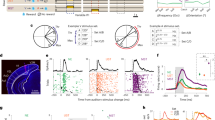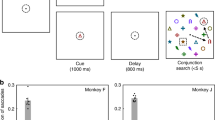Abstract
Although neuroimaging studies confirm the frontal lobe's involvement in language processes and auditory working memory1,2, the cellular and network basis of these functions is unclear. Physiological studies of the frontal lobe in non-human primates have focused on visual working memory and auditory spatial processing in dorsolateral prefrontal cortex (PFC)3,4, although the candidate PFC areas for non-spatial acoustic processing lie in the ventrolateral PFC (areas 12 and 45), which receives afferents from physiologically5,6 and anatomically7,8 defined auditory cortex. We recorded neuronal responses from ventrolateral PFC to auditory cues in awake monkeys under controlled conditions and report that the macaque ventrolateral PFC contains an auditory responsive domain in which neurons show responses to complex sounds, including animal and human vocalizations.
This is a preview of subscription content, access via your institution
Access options
Subscribe to this journal
Receive 12 print issues and online access
$209.00 per year
only $17.42 per issue
Buy this article
- Purchase on Springer Link
- Instant access to full article PDF
Prices may be subject to local taxes which are calculated during checkout


Similar content being viewed by others
References
Gabrieli, J. D. E. et al. Proc. Natl. Acad. Sci. USA 95, 906–913 (1998).
Price, C. J. Trends Cogn. Sci. 2, 281–288 (1998).
Azuma, M. & Suzuki, H. Brain Res. 298, 343–346 (1984).
Vaadia, E. et al. J. Neurophysiol. 56, 934–952 (1986).
Rauschecker, J. P., Tian, B. & Hauser, M. Science 268, 111–114 (1995).
Romanski, L. M. et al. Nat. Neurosci. 2, 1131–1136 (1999).
Hackett, T. A., Stepniewska, I. & Kaas, J. H. Brain Res. 817, 45–58 (1999).
Romanski, L. M. et al. J. Comp. Neurol. 403, 141–157 (1999).
Wilson, F. A. W. et al. Science 260, 1955–1958 (1993).
O'Scalaidhe, S. P. et al. Science 278, 1135–1138 (1997).
Goldman-Rakic, P. S. Phil. Trans. R. Soc. Lond. B Biol. Sci. 351, 1445–1453 (1996).
Benevento, L. A. et al. Exp. Neurol. 57, 849–872 (1977).
Tanila, H. et al. Behav. Brain Res. 53, 63–71 (1993).
Newman, J. D. & Lindsley, D. F. Exp. Brain Res. 25, 169–181 (1976).
Deacon, T. W. Brain Res. 573, 8–26 (1992).
Acknowledgements
This work was supported by NIMH (MH-38546), James S. McDonnell Foundation (JSMF 93-28), and Cure Autism Now.
Author information
Authors and Affiliations
Corresponding author
Rights and permissions
About this article
Cite this article
Romanski, L., Goldman-Rakic, P. An auditory domain in primate prefrontal cortex. Nat Neurosci 5, 15–16 (2002). https://doi.org/10.1038/nn781
Received:
Accepted:
Published:
Issue Date:
DOI: https://doi.org/10.1038/nn781
This article is cited by
-
Neural Mechanisms of the Maintenance and Manipulation of Gustatory Working Memory in Orbitofrontal Cortex
Cognitive Computation (2023)
-
Reward-related choices determine information timing and flow across macaque lateral prefrontal cortex
Nature Communications (2021)
-
Limiting parental feedback disrupts vocal development in marmoset monkeys
Nature Communications (2017)
-
Neuronal Encoding of Self and Others’ Head Rotation in the Macaque Dorsal Prefrontal Cortex
Scientific Reports (2017)
-
Causal contribution of primate auditory cortex to auditory perceptual decision-making
Nature Neuroscience (2016)



